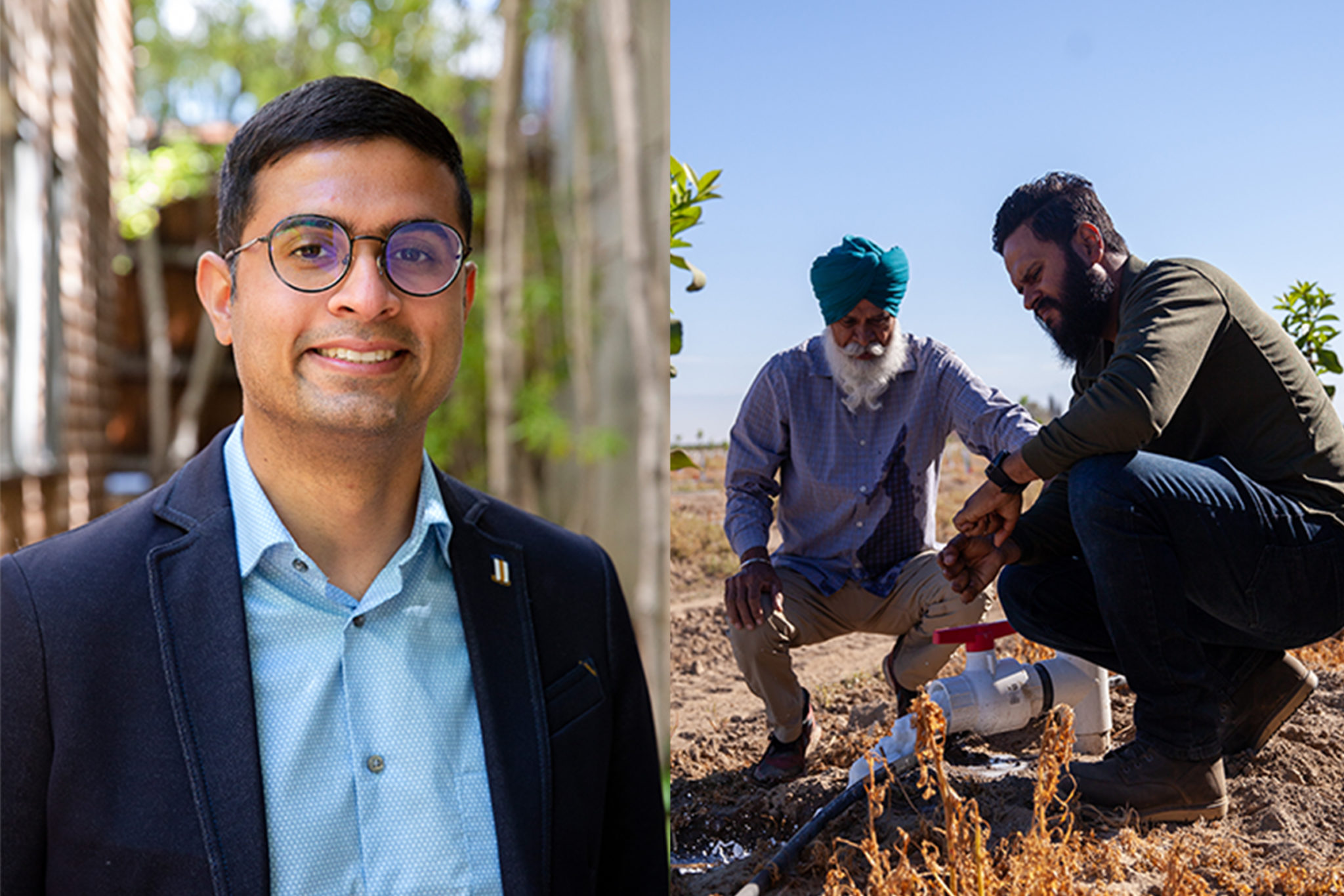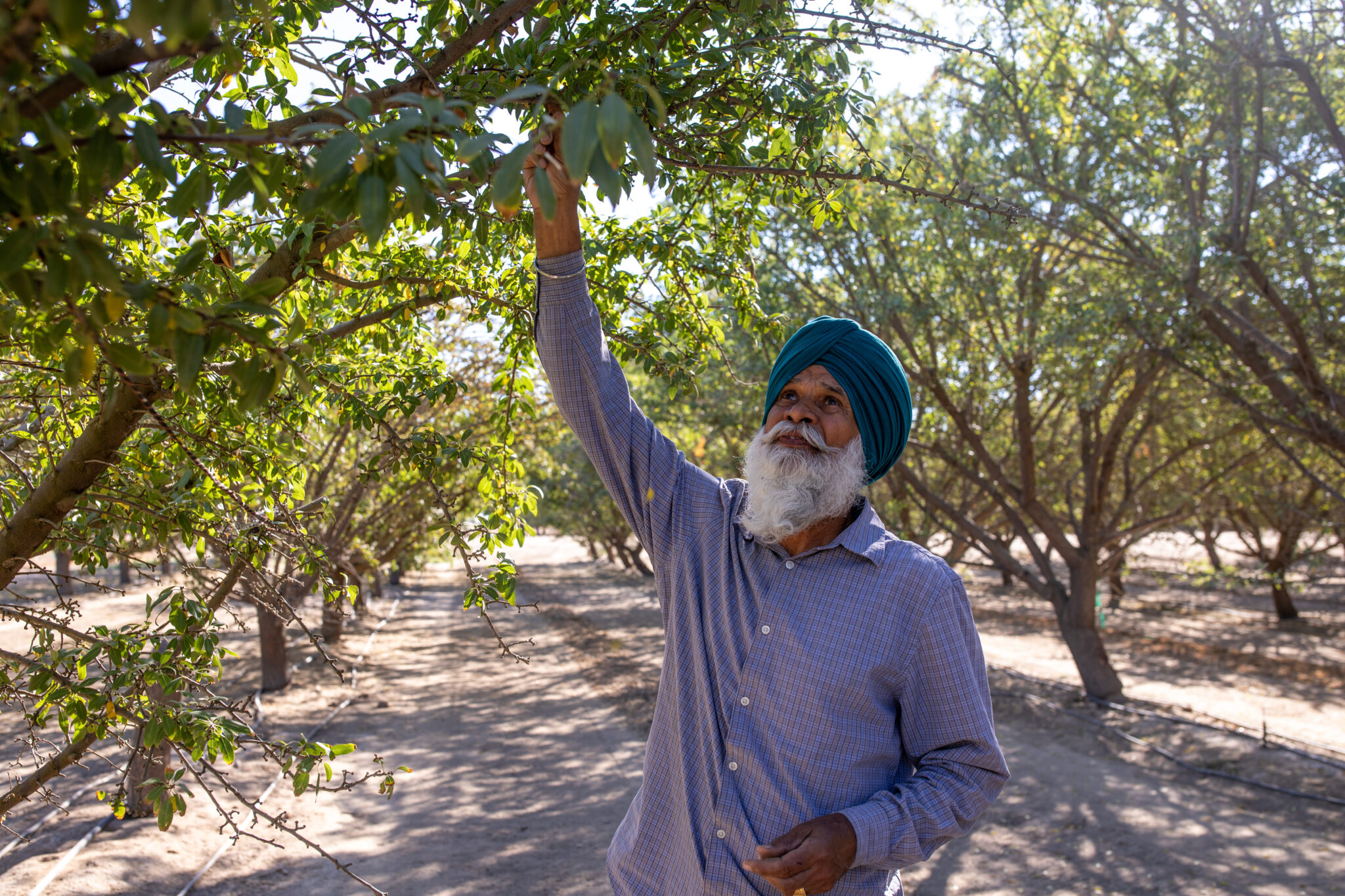Q&A
Aarij Bashir: Punjabi Farmers and the Healthy Soils Program
The recent Goldman School graduate highlights the barriers farmers of color face in accessing state Climate Smart Agriculture funds.

When Aarij Bashir, a recent graduate of the Goldman School of Public Policy, began researching California’s Healthy Soils Program, he knew he wanted to focus on the perspectives of Punjabi farmers. Bashir understood that the Punjabi community, which refers to a broad category of people with roots in the Punjab region of India and Pakistan, has deep ties to the California’s agricultural landscape. Throughout the state, Punjabi farmers work more than 700,000 acres of land, growing everything from stone fruit to table grapes and almonds. A Punjabi farmer named Didar Singh Bains, who died earlier this year, was one of the largest peach producers in the state. The press refers to him as the “Peach King” of California.
But while Punjabi farmers have made significant contributions to the state’s agriculture sector, Bashir recognized their lack of participation in state programs. He set out to find out why.
In a new report published by the Berkeley Food Institute, Bashir points out that there are structural barriers that prevent participation in the California’s Healthy Soils Program, especially for farmers of color and small-scale farmers.
The Healthy Soils Program is a grant-based program launched 2017 by the California Department of Food and Agriculture as part of its Climate Smart Agriculture programs. The goal is to incentivize farmers to implement practices that would help reduce water use, sequester carbon, and reduce greenhouse gas emissions. Practices include composting, planting cover crops, and maintaining hedgerows.
Bashir’s report, called “The California Healthy Soils Program: Perspectives from Punjabi Farmers,” focuses on the Punjabi community to show that farm size, land tenure, access to technical expertise, and language barriers act as major obstacles to the program’s application and implementation. In the report, Bashir also offers policy recommendations, based on interviews with farmers and technical assistance providers, for tackling some of these barriers and making the program more inclusive.
“California is seen as the world leader in climate change mitigation initiatives, and its Healthy Soils Program is an example of that,” Bashir writes in the report. “[The state] must ensure the application process and access to HSP funds is equitable for socially disadvantaged farmers and ranchers.”
Bashir is currently working in Alberta, Canada, promoting climate smart agriculture as a Senior Industry Development Officer for Agriculture and Agri-Food Canada. We recently talked over Zoom to discuss his BFI policy report and its findings and recommendations.
What led you start looking into equity issues in how this program is implemented?
There have been other policy advocates who have raised concerns around equity in this program. CalCAN (California Climate & Agriculture Network) has spoken out about this, saying that programs like the Healthy Soils Program have trouble providing equitable access to minority farmers in California. I spoke to CalCAN when I was doing my initial research.
But my background led me to focus specifically on Punjabi farmers. I am South Asian, and I live and work in Alberta as part of a team that studies agriculture in Western Canada, so I had some understanding of the Punjabi community’s contribution to the agriculture system. In Canada, Punjabis have a significant presence in British Columbia’s production of fruits like apples, blueberries, and strawberries. Some recent statistics say that Punjabi farmers produce 85 percent of blueberries in the province. When I came to California to attend the Goldman School, I noticed something similar. The Punjabi community plays a large role in California agriculture. Punjabis are farming mostly around Yuba City, near Sacramento, as well as in Fresno, and they are contributing significantly to the fruit and nut production in those regions. There are some estimates that say 90 percent of peaches in the Yuba City region are grown by Punjabi farmers, which is astonishing. Of course, a lot of this information is anecdotal and data on Punjabi farmers is not readily available. They contribute a lot, but there’s not a lot of research on this community, unfortunately. I felt that I could contribute to the literature on equity in California agriculture by providing this angle on Punjabi farmers’ perspectives.
Can you describe the methodology behind your research?
This was a capstone project as part of my Master of Public Affairs degree at the Goldman School, so the research itself lasted only four months. My plan was to talk to as many farmers as possible, but I realize that it takes time to build those contacts and relationships, so I conducted interviews with technical assistance providers, who work with tens, even hundreds, of farmers. Technical assistance providers do not work for government, but they work on behalf of governments to deliver these government programs. They are on the ground and have a close understanding of the issues faced by farmers and communities. I also talked to a new farming group called the Punjabi American Growers Group, which also allowed me to focus on aggregate rather than individual experiences. I supplemented that with six interviews with farmers who had either applied for the program or knew about the program to get their perspective on it. All these conversations gave me an understanding of what the common issues are.

Farmer Arshdeep Singh checks on his recently planted citrus orchard in Fresno County. Photos by Austin Price

Farmer Surjan Singh on his family’s almond orchard in Fresno County.
What are some of those issues that you highlight in the report?
The biggest one – and I kept hearing this again and again – is that the application process is too difficult. It requires a COMET-Planner and a mapping tool that needs to be exact. When you’re mapping out the land where you plan to apply the funds, the system will reject your application altogether if you’re off by point-one acre, or if you include something like a shed or part of a driveway. Some farmers would even say to me, “Hey, I have an engineering background, and I still can’t figure this out.” And applications are often rejected or sent back for corrections if there is one small typo. That discourages a lot of farmers to do the application, especially farmers who don’t speak English, or those who do not have the same level of education as others.
Another main issue is the lack of flexibility in how farmers use the practices. One of the parameters is that the practice is applied to a mapped-out part of the farm for three years. If you rotate your crops or change your cover crop, you don’t meet those guidelines, so there is not a lot of flexibility built into the program for diversified farming operations. I have been told that CDFA has been working on making the program more flexible. But farmers still say these parameters can be fairly rigid.
One important issue that came up is that there’s not enough technical assistance or knowledge provided to the farmers about the benefits of these practices and how they can best be implemented. The technical assistance program is more like a grant-writing program at this stage, because all the assistance providers contracted by the CDFA are so busy helping farmers get their applications in and approved that they don’t have the time or resources to really talk to farmers about their farms and what practices do or do not make sense in terms of holistic soil health.
The last issue I’ll mention is the first-come, first-served application process. CDFA used to do batch processing for the first few years of the program, when the amount of funding was lower and easier to manage. I work for government, so I completely understand how a first-come, first-served processing is more efficient in getting the funding out. The challenge, however, is that it takes time for farmers to understand what the system requires or work with technical assistance providers to apply, especially if they do not speak English or are not tech savvy. On the other hand, many large farms can afford staff that are trained to do this and know what the system requires. Small-scale farmers and minority farming communities should not be expected to produce the same quality of application in the same timeframe as some of these larger farmers with resources dedicated to grant writing. It’s important to note that some Punjabi owned farms could be considered large-scale. It was interesting for me to see that they had issues accessing the program as well, but these accessibility issues increased with the smaller-scale farmers.
The current program gives an unfair advantage. The easiest option is to make no changes, but here is an opportunity for CDFA to commit resources to making the program more approachable, to provide access to information to everybody.
Your report includes policy recommendations for fixing some of these issues. What were some of the criteria you used to approach and present policy options?
I built a policy matrix based on five factors and evaluated options according to these criteria: equity, increased adoption of the program, increased number of applications, farmer centricity, and political feasibility. Political feasibility is a key factor when suggesting solutions because I want to focus on improvements to the program that could be realistically implemented. Based on that matrix, I present two recommendations. One of them is a no-brainer. It’s a list of suggestions for equity-based improvements that could be made relatively quickly, even before the upcoming application cycle – suggestions like going back to batch application processing, allowing farmers with short-term land tenure to participate, and giving technical assistance providers more time to conduct outreach. Overall, making the program more farmer-centric.
The second recommendation is for CDFA to experiment with the block grant approach and administer the program through a third-party provider. The idea is that CDFA can deliver Healthy Soils Program funds through an organization on the ground with farming communities, and this organization could then run the program. Using the Punjabi community as a proof of concept, the delivery partner could be the Punjabi American Growers Group or UC Cooperative Extension. I initially thought that this option might not be politically feasible, but there’s precedence of block grant pilots in other CDFA programs, like the State Water Efficiency and Enhancement Program.
As the Healthy Soils Program grows, it’s interesting to see how there might be a trade-off between one of your criteria – increased adoption of healthy soils practices by acreage – and other criteria like equity and number of applicants. How does this factor into how CDFA might approach these recommendations?
I realize that in order to make the changes I propose, CDFA has to recognize that the Healthy Soils Program has an issue with equity the way it is currently running. If the aim of the program is to get the money out as quickly as possible, and to extend to as many acres as possible, then yes, its current approach is working. It’s easier to give a small number of large grants to large-scale farmers than to give a large number of smaller grants to a variety of farmers. Large-scale, mostly white farmers are vying for the max for each funding category.
But I feel that the CDFA needs a mindset change toward equity. I have heard some CDFA staff members say that providing information to any particular community would give an unfair advantage. But the current program gives an unfair advantage. The easiest option is to make no changes, but here is an opportunity for CDFA to commit resources to making the program more approachable, to provide access to information to everybody. The more transparent – the more equitable – the system is, and the more access people have to the knowledge and resources to better manage the soil on their land, the better the outcomes, in my opinion.